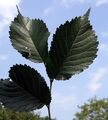Biology:Ulmus 'Dodoens'
| Ulmus 'Dodoens' | |
|---|---|
 'Dodoens', Sir Harold Hillier Gardens, UK | |
| Genus | Ulmus |
| Hybrid parentage | ('Exoniensis' × U. wallichiana) selfed |
| Cultivar | 'Dodoens' |
| Origin | Wageningen, The Netherlands |
The Dutch hybrid cultivar Ulmus 'Dodoens' was derived from a selfed seedling of a crossing of the Exeter Elm Ulmus 'Exoniensis' with the Himalayan Elm Ulmus wallichiana at the Dorschkamp Research Institute for Forestry & Landscape Planning, Wageningen.[1] The tree was one of several cultivars prepared for release in 1970, but delayed by the outbreak of the second, far more aggressive strain of Dutch elm disease.[2]
Description
A fast-growing tree with upright branches. The generally ovate leaves are dark-green, glabrescent, < 14 cm in length by 10 cm broad, with a pronounced acuminate apex.[3][4]
Pests and diseases
'Dodoens' has moderately good resistance to Dutch elm disease, rated 4 out of 5.[5]
Cultivation
Eventually released in 1973, sales in the Netherlands dwindled from a peak of almost 16,000 in 1979 to 600 in 2004.[6] Although still commercially available in Europe, the tree is no longer recommended for planting wherever the disease remains prevalent. Among plantings in the UK is an avenue of 'Dodoens', planted at 12 years old in 2011, lining the path along the River Ribble in Miller Park, Preston.[7][8] 'Dodoens' was originally propagated by grafting onto U. glabra rootstocks, which has proven an unsatisfactory combination in the Netherlands, leading to graft failures in maturity. 'Dodoens' is now grown on its own roots or occasionally on U. 'Stavast'; trees grown by the latter method were planted in the Wijdemeren City Council Elm collection in 2015.
'Dodoens' was included in trials [2] in Canberra, Australia, started in 1988, but has not thrived in that environment, although it prospers further south in the Benalla Botanic Gardens. It is not known to have been commercially released in North America although it was evaluated at the Iowa State University in the early 1970s where it soon perished, unable to tolerate the very cold winters.[9]
Notable trees
The UK TROBI Champion grows at the Westonbirt Arboretum; planted in 1980, the tree measured 20 m high by 47 cm d.b.h. in 2009.[10]
Etymology
The cultivar is named for the 16th-century Flemish physician and botanist Rembert Dodoens.
Accessions
North America
- United States National Arboretum, Washington D.C., US. Acc. no. Q28833 (quarantine)
Europe
- Arboretum de La Petite Loiterie [3], Monthodon, France. No details available
- Brighton & Hove City Council, UK. NCCPG Elm Collection.[11] 1 large tree at Stanmer Park Arboretum, planted 1982. Many trees planted around the city.
- Grange Farm Arboretum, Sutton St. James, Spalding, Lincs., UK. Acc. no. 820.
- Royal Botanic Gardens Kew, UK. Acc. nos. 1980-730, 2000-2071, 2001–839.
- Sir Harold Hillier Gardens, UK. Acc. nos. 1982:4060, 1993:1249.
- Westonbirt Arboretum [4], Tetbury, Glos., UK. Acc. no. 1980/156.
- Wijdemeren City Council, Netherlands. Elm Collection, planted ~1980. Planted mainly in Nederhorst den Berg and Ankeveen.
Australasia
- Royal Botanic Gardens Victoria (Melbourne), Australia[12]
References
- ↑ Heybroek, H.M. (1993). "The Dutch Elm Breeding Program". in Sticklen, Mariam B.; Sherald, James L.. Dutch Elm Disease Research. New York, USA: Springer-Verlag. pp. 16–25. ISBN 978-1-4615-6874-2. https://books.google.com/books?id=avvxBwAAQBAJ&pg=PA16. Retrieved 26 October 2017.
- ↑ Burdekin, D.A.; Rushforth, K.D. (November 1996). Revised by J.F. Webber. "Elms resistant to Dutch elm disease". Arboriculture Research Note (Alice Holt Lodge, Farnham: Arboricultural Advisory & Information Service) 2/96: 1–9. ISSN 1362-5128. https://www.trees.org.uk/kenticotrees/Trees.org.uk/files/90/90f2d2f6-3d77-459c-8288-d951b0bf9782.pdf. Retrieved 26 October 2017.
- ↑ noordplant.nl, 'Dodoens' leaves, Kew Gardens
- ↑ Photograph of 'Dodoens' elm, [1].
- ↑ Heybroek, H. M., Goudzwaard, L, Kaljee, H. (2009). Iep of olm, karakterboom van de Lage Landen (:Elm, a tree with character of the Low Countries). KNNV, Uitgeverij. ISBN:9789050112819
- ↑ Hiemstra, J.A. (2007). Belang en toekomst van de iep in Nederland. Wageningen, Netherlands: Praktijkonderzoek Plant & Omgeving B.V.. http://edepot.wur.nl/21797. Retrieved 26 October 2017.
- ↑ 'Dodoens' avenue in Miller Park, Preston, photo 10, summiteer.co.uk/Nov%202011/Preston/PR05.html
- ↑ Avenham and Miller Parks leaflet, preston.gov.uk/yourservices/culture-parks-and-events/avenham-and-miller-parks/
- ↑ Gibbs, J. N., Brasier, C. M., McNabb Jnr., H.S., and Heybroek, H. M. (1975). Further studies on the pathenogenicity in Ceratocystis ulmi. Europ. Journ. Forest. Path. 5 (3): 161-174
- ↑ Johnson, O. (2011). Champion Trees of Britain & Ireland, p.169. Kew Publishing, Kew, London. ISBN:978-1842464526.
- ↑ "List of plants in the {elm} collection". Brighton & Hove City Council. http://www.brighton-hove.gov.uk/content/leisure-and-libraries/parks-and-green-spaces/list-plants-collection.
- ↑ RBGV (Melbourne) Elm list
 |




